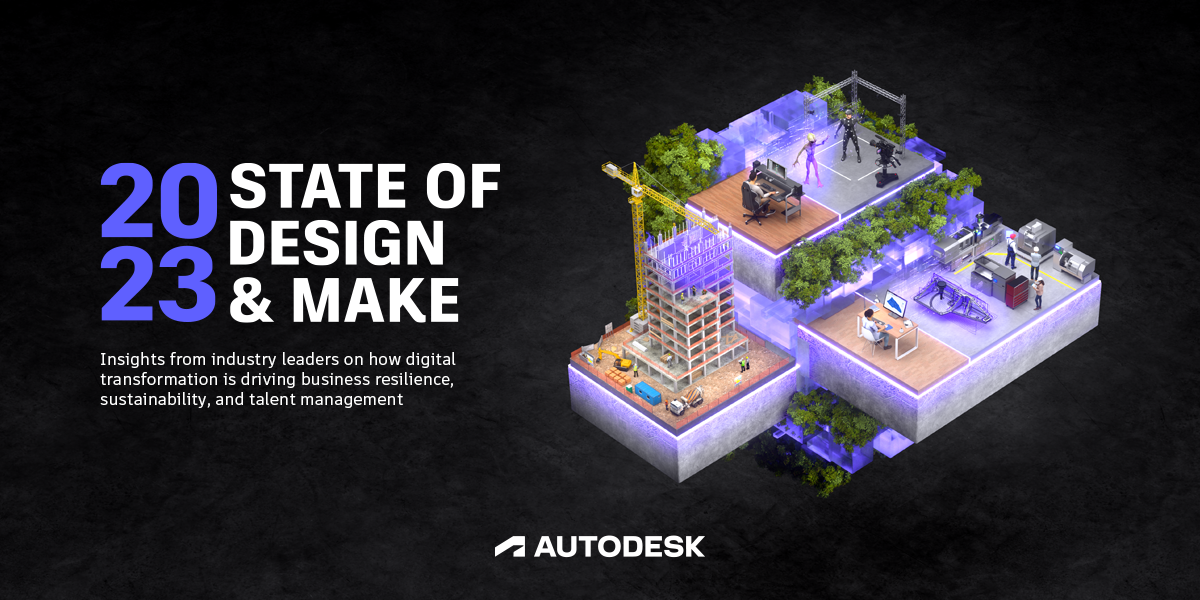Advantage Goes to Digitally Mature Companies
Decathlon—the world’s largest sporting goods designer, manufacturer and retailer—gave itself an Olympic-sized challenge in 2020: to reinvent the bicycle with the help of innovative and sustainable digital tools.
It began with a pledge to reduce its absolute carbon emissions by 20% by 2026 (compared to 2021) in support of the United Nations goal to achieve a carbon-neutral world by 2050. To get there, Decathlon has to adopt new technologies, such as generative design, to integrate sustainability from the start of product design.
“At the end of the day, designing sustainably is essential to remaining competitive. I think the companies that don’t do it will be left behind,” says Charles Cambianica, Decathlon Design Director.
Digitally mature companies thrive
Climate change, war, Europe’s energy crisis and other world-shaking events are spurring Design & Make companies—firms like Decathlon that create the products, buildings and media central to our lives—to accelerate the use of cloud computing and digital tools to transform their businesses, according to the 2023 State of Design & Make report by Autodesk. This is true across an array of industries that have an outsized impact on our daily lives and the planet, including architecture, engineering, construction, product design, manufacturing, media and entertainment, Autodesk found.
Digitally mature companies—those further along in their use of digital tools and data to drive decision-making—are outperforming less digitally mature ones. Their leaders say their companies are more resilient and better able to thrive in a volatile business world, and are more prepared for the major challenges of today’s global events and economy, attracting and retaining skilled workers and managing costs.
Of the more than 2,500 Design & Make leaders, experts and futurists surveyed by Autodesk, 79% said the growth of their company will depend on digital tools.
That’s because digital tools and cloud computing smooth the wrinkles of doing business by connecting the right people to the right data at the right time. Connected data and technologies automate repetitive, tedious tasks such as calculating and recalculating the time and materials needed for a complex, evolving project. Data and technology speed up processes involving many teams from many companies; improve collaboration between people who have never met, yet must deliver multimillion-dollar projects as a team; and pinpoint insights that can help leaders shift supply chains, operations and strategies ahead of a crisis.

Fighting climate change, one product at a time
To shrink the carbon footprint of thousands of products, Decathlon turned to generative design to transform the design process, from ideation to production. In generative design, the software provides alternative solutions based on a designer’s goals and permutations.
For its first project, Decathlon chose the bicycle, a 206-year-old transportation stalwart ripe for transformation. Top models are typically constructed using carbon fiber, a high-performance material with a high environmental cost. Designing the components of a lightweight racing model, Decathlon is using recyclable materials and employing generative design to reduce material consumption.
The company’s 3D-printed Van Rysel PNPL 3.0 concept bike, unveiled in January 2023, offers a glimpse into how artificial intelligence and new manufacturing methods can produce a part, component or entire bike frame—locally and on-demand—from recyclable titanium.
The manufacturing industry is “in a place where we need to rethink the value of design,” Cambianica says, explaining that designers today mustn’t just “look for the aesthetics of the next season,” they need to “understand people’s problems and solve them through design.”

Closing the talent gap and improving collaboration
The workforce has changed more in the last three years than in the previous 25, according to 72% of Design & Make leaders surveyed by Autodesk. Industries are struggling to attract and retain workers. Digitally mature companies are better positioned to close the talent gap because they can draw from a wider talent pool and support a larger remote workforce.
“In hiring, we’ve been able to attract a lot of people because of our technology infrastructure, which allows us to hire people around the globe,” says Jeremy Smith, Chief Technology Officer at Jellyfish Pictures, which delivers visual effects and animation for some of the biggest brands in Hollywood, including Lucasfilm/Disney, Netflix and HBO.
Jellyfish began investing in digital tools and cloud technology more than 10 years ago, long before the media and entertainment industry began to make wholesale changes. Instead of asking artists to come to the studio, Jellyfish brought the studio to the artists.
“We wanted to have everyone under one virtual roof,” says Smith. Cloud-based technology gives production companies the flexibility to quickly shift work to different geographic areas and employ skilled workers, wherever they may be.
Connecting collaborators and breaking silos is the future for the entire media and entertainment industry. “It’s going to lead to a higher quality of work and allow many people from many studios to come together and work as a big team,” Smith says.
Getting it right the first time
International project delivery specialist PM Group manages the design, construction and commissioning of complex, high-tech manufacturing facilities. Advanced technology is integrated into every stage of its projects, says Coral Butler, Group Head of Digitally Enabled Lean Project Delivery.
“In PM Group, we live and breathe ‘Right the first time,’” Butler says. Redoing work blows budgets and deadlines, while getting it right the first time saves time and money. PM Group uses virtual and augmented reality, for instance, to coach subcontractors to install products correctly on the jobsite. By embracing data insights and digital workflows, PM Group delivers projects to clients with increased speed, safety, consistency and quality, says Butler.
Historically, the pressure to deliver on time and on budget has fallen on the makers—be they workers on the jobsite, the shop floor or in production. Digital tools spread that responsibility throughout the entire process, all the way back to those who work on design. These tools enable Design & Make companies such as Decathlon, Jellyfish Pictures and PM Group to make better decisions at the outset, enabling a global workforce, improving efficiency and driving more sustainable operations. They introduce data science that helps build more effective project teams. They help designers catch minor mistakes early, before they snowball into costly problems. And they empower downstream teams with real-time immersive information to make preemptive, informed decisions.
“All of this adds up to far superior delivery,” Butler says. “The digital journey continues, and I don’t believe there will ever be a finish line to cross.”

